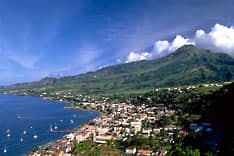Discovering the Allure of Martinique
As you embark on an adventure through the captivating Caribbean, prepare to be enchanted by Martinique. This French island region graces the volcanic arc of the Lesser Antilles archipelago. Nestled between the Caribbean Sea and the North Atlantic Ocean, Martinique lies between Dominica to the north and Saint Lucia to the south. The atmosphere radiates beauty, history, and unique culture, making it an irresistible destination.
Geographical Marvels of Martinique
Martinique stands as the third-largest island in the Lesser Antilles, coming in after Trinidad and Guadeloupe. Spanning 1,100 km² (or 436 sq mi), it measures slightly smaller than the Faroe Islands. To put its size in perspective, it is a little over six times larger than Washington, D.C. This rich geography not only shapes the island's culture and lifestyle but also gives visitors a vibrant landscape filled with breathtaking coastal scenery and mountainous terrain.
A Population Steeped in History
As of 2014, the vibrant population of Martinique reached about 381,000 residents. Fort-de-France, the capital, serves as the heartbeat of the island, reflecting a blend of tradition and modernity. Most inhabitants descend from African slaves who were brought to the island to work on sugar plantations during the colonial era. Today, this rich history adds depth to the character of Martinique, offering visitors a chance to engage with its past while experiencing its vibrant present.
The Historical Tapestry of Martinique
Colonial Beginnings and Historical Changes
Martinique’s journey began in 1502 when Columbus first landed at Carbet on the Caribbean side. The island officially became a French possession in 1635, thanks to the efforts of Pierre Belain d'Esnambuc. Following this, the island underwent various changes and challenges. In 1636, King Louis XIII permitted the introduction of slaves to French territories in the West Indies. This decision laid the foundation for the island’s socio-economic structure, particularly in sugar production.
The Black Code and Its Impact
The establishment of Colbert's infamous "Black Code" in 1685 marked a significant turning point. This code governed the lives of slaves across 60 articles until its abolition in 1848, reflecting both the resilience and struggle of the population. The island faced several British occupations between 1762 and 1848, which shaped its historical narrative and cultural identity.
Abolition and Transformation
When May 22, 1848, arrived, it signified the end of slavery in Martinique, marking a moment of liberation. Following this, significant events continued to shape the island. The catastrophic eruption of Mt. Pelée on May 8, 1902, destroyed the city of St.-Pierre and transformed Fort-de-France into the capital. This disaster served as a catalyst for change, showcasing the island's geographical volatility and resilience.
Modern-Day Martinique
On March 19, 1946, the people of Martinique gained the status of an overseas department of France. Since then, its political landscape has continued to evolve, and the establishment of the Regional Council in 1983 further paved the way for local governance. Today, Martinique thrives as an essential part of the French Republic, with four deputies and two senators representing it in the French parliament.
The Cultural Fabric of Martinique
The people of Martinique, known as Martiniquais, showcase a beautiful blend of cultures—a reflection of their African, French, and Indian roots. The majority of residents practice Christianity, with over 90% identifying as Christian. Furthermore, the official language is French, while a rich Creole patois thrives in daily interactions, ensuring the preservation of local traditions and expressions.
A Treasure Trove of Natural Resources
From stunning coastal vistas to lush interior landscapes, Martinique is a jewel of natural beauty. The island boasts a plethora of tourist-friendly coastal scenery and cultivable land. Furthermore, its agricultural sector is vibrant, producing pineapples, avocados, bananas, flowers, vegetables, and sugarcane, catering to both local and export markets.
Industries that Drive Martinique’s Economy
The economy of Martinique thrives on a diverse range of industries. Tourism plays a vital role, drawing visitors eager to explore the island's natural beauty, rich history, and cultural diversity. Other significant sectors include construction, rum production, cement manufacturing, and oil refining—all contributing to the island's economic framework.
Delights of the Martinique Experience
When exploring this Caribbean treasure, one cannot overlook the culinary delights that Martinique offers. The island is renowned for its rum, with distilleries preserving traditional methods while embracing innovation. Visitors can indulge in local delicacies featuring fresh produce from the vibrant markets, where tourists experience a true taste of Martinique's culture.
Climate and Outdoor Activities
Martinique enjoys a maritime tropical climate, complemented by refreshing trade winds. The island experiences a rainy season from June to October, which nourishes its lush vegetation. Outdoor enthusiasts can partake in a variety of activities, from hiking the mountainous trails to snorkeling in crystalline waters, truly immersing themselves in the island's natural wonders.
In Summary
Ultimately, Martinique stands as an intriguing blend of history, culture, and natural beauty. As you wander through its vibrant landscapes and engage with its rich past, you will discover a unique connection to this enchanting Caribbean island. With its breathtaking scenery, delicious cuisine, and warm, welcoming people, Martinique is a destination that promises unforgettable memories.
Largest cities of: Martinique
| City Name | Population | Year of foundation | |
| Fort-de-France | 85,000 | 1635 | |
| Le Lamentin | 32,000 | 1635 | |
| Saint-Martin | 29,000 | 1635 | |
| Sainte-Marie | 20,000 | 1635 | |
| Le Robert | 18,000 | 1635 | |
| Case-Pilote | 10,000 | 1635 | |
| Saint-Joseph | 7,000 | 1856 | |
| Le François | 6,000 | 1680 |


